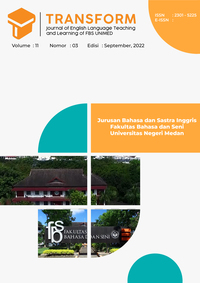Gender and Politeness of Request Expression on Whatsapp
DOI:
https://doi.org/10.24114/tj.v11i3.44031Keywords:
Politeness, Gender, RequestAbstract
The research discussed about politeness strategy used by male and female students in requesting on WhatsApp message. The aims of this study were: to find out the types of politeness strategy used by male and female students by using Brown and Levinson (1987) politeness theory, to find out the differences and reason of politeness strategy used by male and female students in requesting on WhatsApp. The descriptive qualitative method were used in this research, and the data were derived from the WhatsApp message script. The findings of the study showed that male students applied 3 politeness strategies proposed by Brown and Levinson (1987): bald-on record (21 sentences), positive politeness (8 sentences), negative politeness (3 sentences). The researcher also found that female students applied 4 politeness strategies proposed by Brown and Levinson (1987): bald-on record strategy (5 sentences), positive politeness (7 sentences), negative politeness (17 sentences), and off record (5 sentences). The significant difference in politeness strategies used by male and female students are that there is no off record strategy used by male students, they apply the bald-on record strategy more often, while female students are more varied in using of politeness strategies and mostly applied the negative politeness. The difference of male and female students politeness strategy in requesting on WhatsApp because each gender has own way in conveying their want. Male students were more direct when requesting to others, while female students were more indirect when requesting to others.Downloads
Published
2023-03-11
Issue
Section
Articles
License
Copyright (c) 2023 Zuhra Saritza, Muhammad Natsir

This work is licensed under a Creative Commons Attribution-ShareAlike 4.0 International License.
Authors who publish with this journal agree with the following terms:
- Authors retain copyright and grant the journal right of first publication with the work simultaneously licensed under a Creative Commons Attribution License that allows others to share the work with an acknowledgment of the work's authorship and initial publication in this journal.
- Authors are able to enter into separate, additional contractual arrangements for the non-exclusive distribution of the journal's published version of the work (e.g., post it to an institutional repository or publish it in a book), with an acknowledgment of its initial publication in this journal.
- Authors are permitted and encouraged to post their work online (e.g., in institutional repositories or on their website) prior to and during the submission process, as it can lead to productive exchanges, as well as earlier and greater citation of published work (See The Effect of Open Access).
- This work is licensed under a Creative Commons Attribution-ShareAlike 4.0 International License.

This work is licensed under a Creative Commons Attribution-NonCommercial-ShareAlike 4.0 International License.



